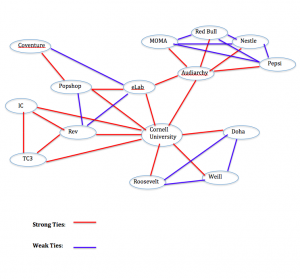Cornell Entrepreneurs Network
Article Referenced: http://www.forbes.com/sites/natalierobehmed/2014/07/30/silicon-ivy-how-cornell-is-prepping-young-entrepreneurs/
This article is about the various entrepreneurs that have graduated from Cornell, and how the numerous student run organizations at Cornell have contributed to these entrepreneurs’ success and therefore their connection with companies after graduating. The article begins by talking about Jake Reisch, who started Audiarchy, a company that provides silent discos. However, Reisch didn’t get to this point on his own – eLab, an organization that helps students pursue their startup ideas, backed up Reisch’s idea. The author of this article delves into the other various startups that have succeeded because of the help that eLab provides. The article also touches on the increasing number of Cornell campuses all over the world, as well as other organizations that are dedicated to seeing great startup ideas through, such as Popshop. All of these organizations, as well as Cornell’s ever increasing presence around the world are cited to be contributing to the number of entrepreneurs that Cornell has bred.
When I read this article, I immediately thought about how all of these connections between Cornell’s campuses, students, organizations, and outside companies have formed a network. I thought it nicely tied into what we learned in class about triadic closure and bridges existing in networks. I made a network graph of the companies and locations that Cornell is connected to, and drew in edges that satisfy triadic closure. I also show where local bridges exist and do not exist. For example, Cornell is connected to eLab, and eLab is connected to Audiarchy because of Reisch – these links are strong ties, causing a strong tie to exist between Cornell and Audiarchy. Another instance of strong triadic closure in this network is the following: Cornell has a strong tie with CornellTech on Roosevelt Island, and Cornell also has a strong tie with Weill Cornell Medical College, therefore CornellTech and Weill have formed a weak link through their association with Cornell University. Another occurrence of strong triadic closure can be seen between Cornell’s strong links to Popshop and eLab, which are also connected with a strong tie. Furthermore, Cornell’s recent strong tie with Rev, which aims to continue Cornell’s success with startups as well as propelling these achievements into the community by also connecting with Ithaca College (IC) and Tompkins County Community College (TC3), has created strong ties and therefore triadic closure between Cornell, IC and Rev, between Cornell, Rev and TC3, and between IC, TC3, and Rev.
Not all of the triangles form triadic closure, however. For example, although Cornell and TC3 have a strong tie because of Rev, TC3 and the Roosevelt Island Tech Campus aren’t connected – at least not yet. This violates strong triadic closure because Cornell has strong ties with Roosevelt and TC3.
In the network graph below, all of these links and more are drawn out. I thought this network graph was really interesting in relation to the article because it provides evidence of how important connections are in achieving success and how these connections have widened Cornell’s impact and its students impact on the world. Although there are numerous violations of triadic closure, this means that in the future, if more connections are made and more triadic closure exists, we will see even more success in the startup world at Cornell.

